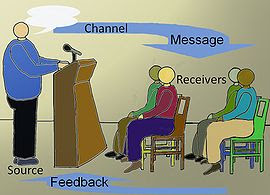American
Degree Programme 2012
Segi
College Kuala Lumpur
Introduction
to News Reporting/Interpersonal Communication
COMM
132/ COMM 100
Dhivasakti
d/o Yogandran
SC-KL-00035739
Mr.Mohd
Khalil
Simple Model Of Communication
People-(Sender / Encoder)
Sender / Encoder is
a person who sends the message. A sender makes use of symbols (words or graphic
or visual aids) to convey the message and produce the required response.Sender
may be an individual or a group or an organization. The views, background,
approach, skills, competencies, and knowledge of the sender have a great impact
on the message. The verbal and non verbal symbols chosen are essential in
ascertaining interpretation of the message by the recipient in the same terms
as intended by the sender.
Message –
Message is a key idea
that the sender wants to communicate. It is a sign that elicits the response of
recipient. Communication process begins with deciding about the message to be
conveyed. It must be ensured that the main objective of the message is clear. A message may be spoken, written, visual, and
physical signals. Some qualities of a message include its wording, directness,
and purpose.
Each message has a specific purpose:
~to convey important facts or information
~to persuade the receiver to accept or reject certain
conditions or actions
~to motivate the receiver to act in a specific way
~to stimulate discussion about a particular issue, or
~to entertain the receiver
Messages can have many other purposes, like instructing,
warning, greeting, or requesting information. For a message to be effective,
you should know exactly why you plan to send it.
The Channel
-A medium is used to
exchange / transmit the message. The sender must choose an appropriate medium
for transmitting the message else the message might not be conveyed to the
desired recipients. The choice of appropriate medium of communication is
essential for making the message effective and correctly interpreted by the
recipient. This choice of communication medium varies depending upon the
features of communication. For instance - Written medium is chosen when a
message has to be conveyed to a small group of people, while an oral medium is
chosen when spontaneous feedback is required from the recipient as
misunderstandings are cleared then and there. The most commonly used channels
include air, light, electricity, radio waves, paper, and postal systems. There
may be multiple parallel signals, as is the case in face-to-face interaction
where sound and gesture involve different signal systems that depend on
different channels and modes of transmission. There may be multiple serial
signals, with sound and/or gesture turned into electronic signals, radio waves,
or words and pictures in a book.
Feedback –
Feedback is the main
component of communication process as it permits the sender to analyze the
efficacy of the message. It helps the sender in confirming the correct
interpretation of message by the decoder. Feedback may be verbal (through
words) or non-verbal (in form of smiles, sighs, etc.). It may take written form
also in form of memos, reports, etc. . Often, feedback is essential, because
it's what turns one-way communication into two-way communication. Feedback may
be positive or negative:
*Positive feedback indicates the receiver has received and
understood the message.
*Negative feedback indicates that the receiver either has
not received the message or has not understood its content
Feedback is important during communication because it helps
the sender to make any necessary adjustments so that the message is correctly
received. Feedback is also important after you've delivered a message. It
enables further clarification or discussion.
Each component is affected by many variables and varies
across situations, it's essential that communicators take the time and effort
to plan and target their messages carefully.


No comments:
Post a Comment